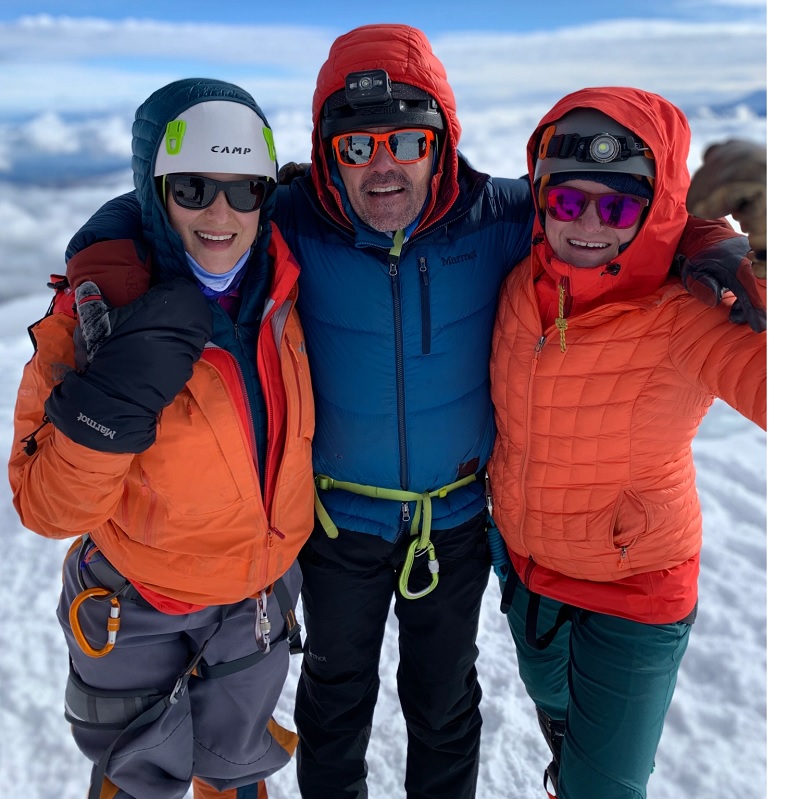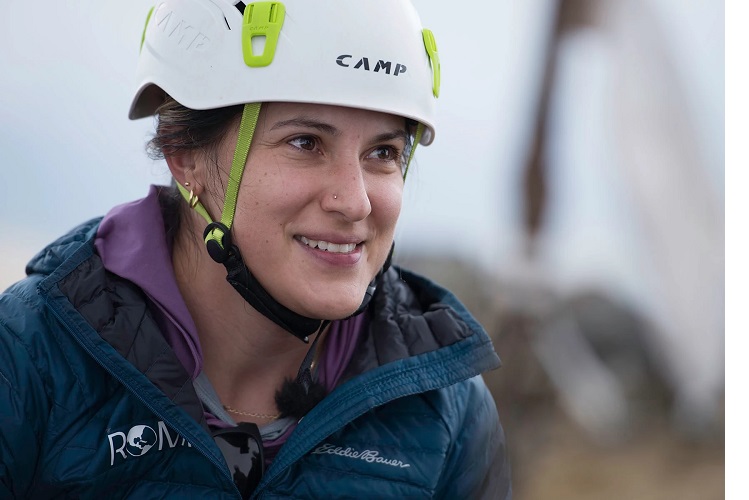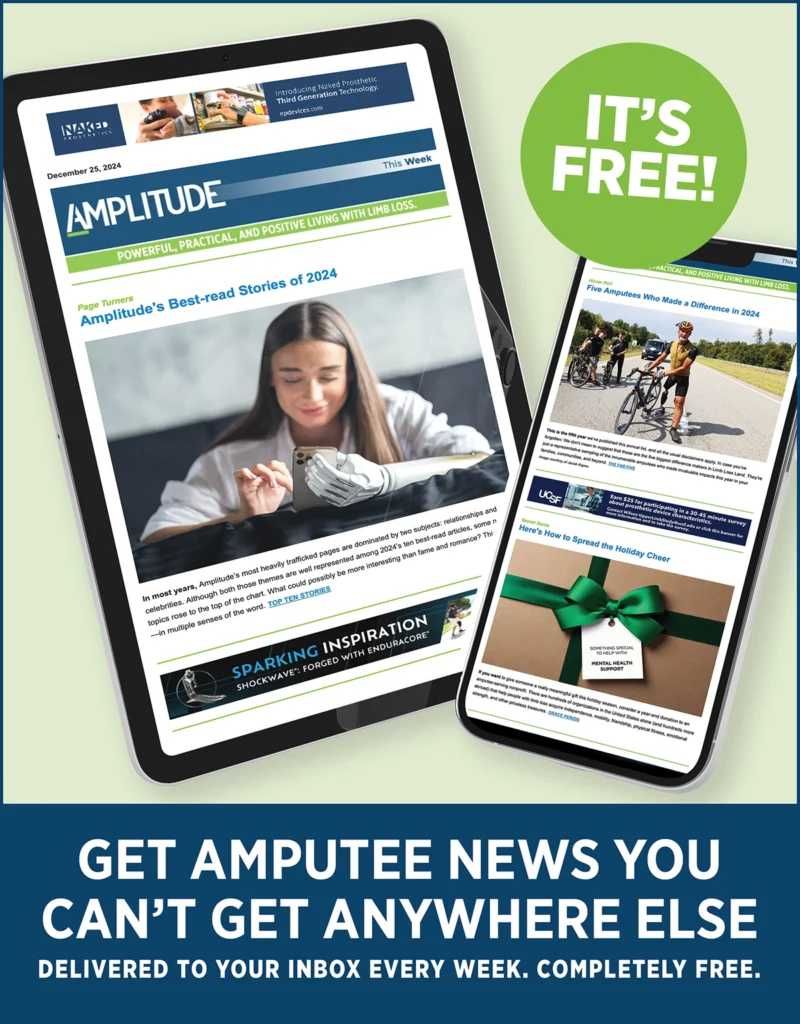by Lacey Henderson
This guest post comes from Paralympic long-jumper Lacey Henderson and is adapted from “It’s the Climb,” originally published at Lacey’s blog. Join Lacey on December 3 for Level Up!, a virtual celebration of mobility and empowerment for amputees all over the world. Registration is free.
“The important thing is not to win, but to take part.” This quote from Pierre de Coubertin, founder of the modern Olympics, is very familiar in the realm of international athletics. But this summer, I felt my opportunity to show up for the Paralympic Games was taken away from me. Despite meeting national team standards in my event (long jump), setting regional records, and winning Paralympic team trials, I did not hear my name called to represent Team USA in Tokyo. I was devastated. I felt robbed by loopholes in selection criteria and a dash of bad luck.
But the hardest part wasn’t that I felt betrayed. It’s that I felt like a betrayer. My partner and family members had uprooted their lives in support of my goal. We moved states, endured a pandemic, spent time and money that took us away from other things, all to support my competing in Tokyo. I’d done everything I could to keep up my side of the deal and make everyone’s sacrifice worth it, but I still came up short.
I felt really guilty—like I’d let everyone down.
In the midst of my disappointment, I got a phone call from Lauren Panasewicz (better known as LP), director of development for the Range of Motion Project. “I don’t want to be insensitive,” she said, “but I have a feeling your passport is up to date?” This clever woman was right! My book was all ready to be stamped for Tokyo, but now I had no destination. LP had an alternative at the ready: “We would love to have you come and join us with an Elite Team Climb in an attempt to summit Cotopaxi,” she said.
I’d had a few previous conversations with LP about ROMP’s annual fundraising trek in Ecuador, which has taken place every year since 2015 (except 2020, due to the pandemic). The timing never worked out because I was always training for track, but in this case the timing was perfect. I wanted to run away from reality; I was desperate for relief. Gallivanting off to Ecuador to skip to the top of some mountains seemed like an opportunity to find who I was again, outside of the track.
Years ago, one of my coaches asked me to help a teammate who, like me, had a history with cancer. It was a weird time in my life, and I was managing a lot of emotional turmoil, so when I expressed my hesitation—I wasn’t in a good head space, I was going through my own stuff, I didn’t know what to say—my coach said: “Sometimes we fill our cups by filling others.”
LP’s offer brought those words back to mind. I was feeling broken after losing my shot at the Paralympics, and after advocating for myself against a giant system designed to make me feel disposable. But even in my pain, I realized my life has been decorated with privilege. I’ve only had one bad prosthetic experience in my whole life, which is basically unheard of. I’ve had the opportunity to compete in cheerleading, college athletics, and international track and field. I’ve never wondered how I’d be able to get the equipment I need. I’ve had a strong support system where everyone gives their best effort to see I succeeded.
ROMP exists for the 90 percent of the world’s amputees who are far less privileged, and who can’t get access to even the most basic assistive technology. ROMP’s global mission is to provide prosthetic and mobility devices to underserved amputees in the US, Ecuador, and Guatemala. This was a cause I could easily support, and have supported over the years with the Amputee Coalition’s youth camp. I knew my life experience, my voice, and even my pain could fill the cup of others while I waited for healing for myself.
Despite being a Colorado native, I had no experience in mountaineering, and there wouldn’t be much time to train before the trip. But I’d just had the best track season of my life, so I figured I was in good enough shape. Hiking is just walking, right? I agreed to go, secure in my ability to haul my experiences, knowledge, and privilege up Cotopaxi to help others.
I never considered that I might have to surrender my pride and accept help from somebody else.
After I lost my right leg to cancer at age 9, I spent decades trying to “make up” for needing help. I call this my “super-amputee” phase, where I tried to prove to everyone—most importantly myself—that I didn’t need anyone to take care of me. This was my way of seeking forgiveness for the sin of being dependent. When you acquire a disability, it doesn’t just disrupt your own life, it disrupts everyone around you. That’s incredibly hard, especially for women, who are raised not to make noise and to be agreeable and accommodating.

as she hosts Level Up!, ROMP’s virtual
end-of-year bash. Get info here.
Photo by Andres Molestina.
Genetically, I am not designed like that. I played sports. I got good grades. I got scholarships. Graduated Cum Laude. Became a professional athlete. Became the best in the country. Performed on the biggest stage in the world. Started my own business. That competitive drive has always been in me, but a part of it came from a place of shame over my disability.
The funny thing about mental health, especially after you have sorted through some deep-seeded stuff, is that your unhealthy thoughts don’t ever actually go away. You carry them around and just learn to manage them better while still moving forward with life. I came into therapy only knowing how to use a hammer to smash my problems to pieces, but my psychologist helped me find new tools. Because not every challenge is a nail that you can pound into submission. Some are screws you have to tighten. Some are burrs you file down.
And some, I discovered shortly after joining my ROMP teammates in Ecuador, are ropes you cling to on the side of a glacial volcano in the Andes.
I would love to assert that I handled this new challenge with grace. But even though I was acutely aware of having my every word recorded by videographers from one of ROMP’s sponsors, I did not nail it in the poise department during our training hike on Ruminahui, a couple of days before the Cotopaxi ascent. The amount of profanities I was shouting in between shallow, high-altitude breaths would even make my Italian grandmother blush. This was more than a hike. It was more than a climb. It was my opportunity to look into a mirror made of the earth while being pushed to a point of frustration and discomfort. And it was also a chance to realize that, after months of feeling like I was being pushed down by forces beyond my control, there were hands reaching for me to pull me back up and push me forward.
When we reached the summit of Ruminahui, I wept. A tangle of emotions came out in those sobs—my frustration at the obstacles that kept me from Tokyo, as well as my gratitude for the support of the people around me. My ROMP teammates helped me see that I could still overcome the obstacles that really mattered. It felt like a hyper-condensed version of my career in athletics—and as an amputee. You measure your progress in tiny increments, meters or centimeters, while learning more about yourself than any school will ever teach you. When it goes well, it’s the best high in the world. When it doesn’t go well, it feels like a curse.
You would think after my run-in with Ruminahui that I would heed the warning of wait might await on the climb to Cotopaxi. But the distance was shorter, I had acclimated to the altitude, and I now had “experience.” And I was with a group of dynamic people, both disabled and non-disabled, who cared about something greater than themselves. It felt like family. I was vibrant with anticipation.
Before this trip, I was hesitant about spending so much time in the company of “mountain people.” I was so far out of my element, I might as well have been an alien from another planet. But from the day I arrived, everybody made me feel welcome. Karl Egloff—the fastest man to summit these mountains—spent time talking with me about the similarities between elite athletics and advanced mountaineering. Paul, the workhorse guide on my rope team, was indisputably the most patient man alive. I was the slowest, weakest, and loudest person on the climb. But even though I had entered a sacred space for these mountain people and didn’t honor it the way I knew they did, they still made me feel cared for and important.

That was probably the most moving part of the entire trip. I was carrying so much guilt and shame for things beyond my control that I didn’t realize how heavy it felt. The day before we left for the Cotopaxi summit, as I struggled and complained on a lower stretch of the mountain, Karl offered to grab my backpack. When he took the load from me, I almost felt like I levitated—and I recognized, with a shock, how much weight I’ve been dragging around. I was reminded of a quote I used to love: “It’s not the load that breaks you down. It’s how you carry it.”
That thought reverberated with every step on the summit ascent. If there is a hell for amputees, it’s covered in sand and ice. Cotopaxi has both. We started up at 10 pm, and it immediately became obvious that climbing an icy mountain in sheer darkness with no experience was going to require one thing – mental toughness. Panic is the enemy. Thinking about how bad it hurts is not helpful. Worrying that you’re not getting enough oxygen is not productive. Whenever I exerted a lot of energy I would feel nauseous, so I became hopeful that if I puked maybe Paul would let me quit. As if he was reading my mind, Paul turned around, looked me in the eyes, and said: “We are not turning around.”
When the sun started to rise and I saw we weren’t close to the summit (although we were close, according to the mountain people), it started to feel impossible. My feet kept sliding, and Karl started grabbing my boots to place them onto more substantial surfaces, and I began catastrophizing that I would stab Ecuador’s favorite mountain hero with my rented crampons. For every step he took, I needed about six, because my foot slipped back with every movement. But there was nothing to do but keep moving forward. LP used her ice ax to help leverage my back [prosthetic] foot, so I had something to push off. Between her, Karl, and Paul, I was pushed, pulled, and dragged for what felt like an eternity to get to the top.
I couldn’t help but laugh at how hard it felt just to move. I almost didn’t recognize my own body or how it worked. I was even too exhausted to cry, and that surprised me. I had literally cried every day on that trip, because I was petrified with fear that I would let everyone around me down again. Now that I had reached the summit and achieved my goal, what struck me was that it isn’t the actual success that people support. It’s the effort. My success in reaching the summit depended on others, but the effort was 100 percent my own. I understood Pierre de Coubertin’s words—“The important thing is not to win, but to take part”—in a new way.
All my tears on this trip—and over my life—had been shed in frustration over trying to compensate for something that happened to me that was out of my control. But at the summit of Cotopaxi, it was as if all that weight disappeared. All I could see were blankets of bright, white rolling clouds and smiling faces. It felt infinite and peaceful. I returned to the thought that entered my head when Karl took my backpack: “It’s the way you carry the load the makes it heavy.” I had finally escaped the gravitational draw of painful events and unproductive beliefs. The struggle up the mountain illustrated how far I needed to go to break away from the things that pulled me down daily.
I joined ROMP’s climb to Cotopaxi to offer my experience as a professional athlete and an amputee. In sharing myself, I received more help than I could have ever imagined. ROMP uses the summit as a metaphor for overcoming life’s challenges, but nobody can get to the top of that mountain in solitude. When you get pushed down, someone else extends a hand to carry your bag and help pull you back up. And then we do the same thing for somebody else. We rise by lifting others.
More in Amplitude about Lacey Henderson
“Picked Last in Gym Class”
“Lacey Henderson Looks Ahead”





